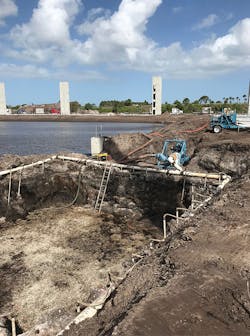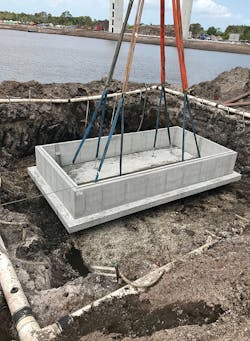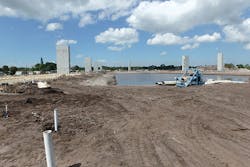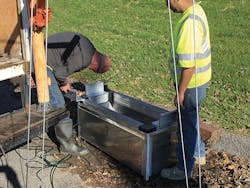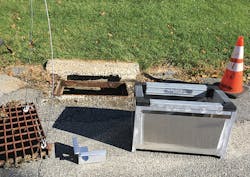Whether they’re in place to protect a drinking water supply or aquatic life, drainage and filtration systems act to keep pollutants and debris out of the storm sewer system. Increasing development and the associated creation of impermeable surfaces call for solutions that are cost-effective while offering an optimal level of performance.
Palm Bay, FL
The 156-mile Indian River Lagoon plays a large role in Palm Bay, FL’s economic and residential growth, and it needs to be protected from future stormwater pollution as the area redevelops.
Palm Bay is experiencing an influx of jobs driven by major tech employers located within and surrounding the city, including Harris/L3, the Florida Institute of Technology, Northrup Grumman, and Raytheon, among others.
Opportunities for a highly skilled, young, technical work force to live in the city have been hampered by the lack of a downtown district or new rental apartments. Palm Bay formed a business improvement district, establishing the Bayfront Community Redevelopment Agency in an effort to retain tech workers in town by helping private developers to create a downtown district.
Northshore Development is developing a mixed-use project, anchored by a 320-unit apartment complex near the Indian River Lagoon.
The lagoon has experienced years of heavy nutrient pollution and land disruption issues, spawning algae blooms, fish kills, and habitat loss. To stem the decline, the City of Palm Bay, the St. Johns River Water Management District, the Florida Department of Environmental Protection, and the counties of Brevard, Volusia, Martin, and Indian River banded together to create the Indian River Lagoon National Estuary Program Council. Its aim is to use strategic projects to reduce 900,000 pounds of combined nitrogen and phosphorus loads by 2028.
While many stormwater pollution reduction projects have been funded entirely by the municipalities and other public sector entities, an increasing number of private ventures are helping eliminate large portions of nonpoint-source pollution entering the lagoon.
Northshore’s mixed-use project is one such venture. There were stormwater mitigation challenges in constructing the apartment complex.
“This is a very difficult property to get the drainageand stormwater right on, because next to it is an old mobile home park from the 1970s that was built a little lower than it should have been,” says James Shonkwiler, chief development officer and COO for the Northshore Development Group.
With new drainage and storage regulations, in an effort to match post-development flow to that of pre-development, the project called for the use of 3 feet of fill above what the neighboring property owner in the same watershed to the south of the site had used, Shonkwiler says, adding that a highway and railroad north of the site posed another concern regarding water flow.
“We wanted to make sure we didn’t flood this trailer park,” says Shonkwiler. “The soils were not really good. The site served as a storage area and was flooding and pushed back up. When we built the project there, we had to meet the current stormwater regulations of four inches of treatment and find a way to avoid flooding the mobile home park in any event at all, so we went all the way to the 100-year storm event.”
That necessitated building bigger ponds, which take up 22% of the site, says Shonkwiler.
“We have a lot of storage on site,” he says. “That leads us to stormwater treatment. The way you treat stormwaterin Florida typically is to build a dry retention pond or elevate your existing ponds even more so it could percolate down through the soils.”
He adds, “We didn’t have good soils in the substrate for drainage. We put new soils in. We would have had to bring in another one or two feet, which made it even more difficult to avoid flooding the low-lying areas to the south of the trailer park.”
The alternative was to use two Nutrient Removing Filtration System (NRFS) vaults with integrated biosorption media to manage and treat runoff from the site, protecting the lagoon from nutrient pollution and keeping it as an attractive local ecosystem.
The NRFS is an engineered vault treatment system for the reduction of nutrients and sediment within stormwater runoff. Designed and manufactured by Suntree Technologies, an Oldcastle Infrastructure company, the Northshore Development’s NRFS vaults utilize Bold & Gold biosorption activated media along with an orifice flow control to maximize detention time to remove large amounts of total suspended solids (TSS), phosphorus, nitrogen, metals, and hydrocarbons.
Bold & Gold is designed to form sorbent surface bonds with water molecules to efficiently establish a media nutrient cycle that captures nutrients via biological consumption, resulting in the denitrification of runoff, ensuring its purity upon discharge and preventing the possibility of algae blooms in the lagoon.
Installation of the two NRFS vaults took place on March 28 in a single day as crews battled wind gusts, rain delays, and blown tires on one of the eight wide-load trucks delivering sections of the precast vaults. The installations were accomplished through teamwork led by site contractor South Florida Grading Inc. and including Northshore Development, the city of Palm Bay, Ferguson Waterworks, Oldcastle Infrastructure, Suntree Technologies, and the general contractor, Roger B. Kennedy.
“It kept us from adding more fill to the site and saved us in terms of retaining walls,” says Shonkwiler of the installations.
Brewster Heights
A project to reduce phosphorous in New York City’s drinking water supply has entailed a collaborative effort of several parties over the past decade, including the Eastof Hudson Watershed Corporation (EOHWC), a local development corporation established by the municipalities in Northern Westchester, Putnam, and Dutchess counties in the New York City watershed.
The goal of the corporation is to install stormwater retrofit projects to meet phosphorus reduction requirements defined by the New York State Department of Environmental Conservation (NYSDEC).
The corporation works in conjunction with NYSDEC and New York City Department of Environmental Protection (NYCDEP) to further stormwater quality projects in the Croton and Kensico Reservoir basins.
A recent project site, Brewster Heights, occupies approximately a half a square mile in the town of Southeast in southern Putnam County, NY.
The initial goal of the project was the stabilization of four heavily eroded channels that discharged runoff from a Brewster Heights subdivision. The channels had caused severe washout and sediment deposition onto private property and into the New York City water supply Middle Branch Reservoir. The team sought to identify an appropriate water-quality best management practice (BMP) to address the problem.
One consideration was the installation of two hydrodynamic separators (HDS), individually located at the outfalls of the two channels where runoff was to be rerouted. The units’ location would have required realignment of multiple existing utilities and occupied a significant footprint within the right of way.
The existing phosphorus load of the drainage area tributary to the stabilized channels was calculated as 22.46 kilograms per year (kg/yr). The reduction credit attainable through installation of two HDS units would have been 2.25 kg/yr. The estimated installed cost was between $80,000 and $100,000, not including the realignment of existing utilities.
The ultimate decision was to use Fabco Industries’ StormBasin instead. This BMP had been approved by NYSDEC and provides 50% phosphorus removal at its peak treatment flow rate. It can be retrofitted into existing catch basins.
The StormBasin is designed to capture and retain stormwater catch basin pollutants including sediment, trash, vegetation, nutrients, coliform bacteria, oil, grease, and dissolved metals such as lead, copper, cadmium, and chromium. Cartridges are available in various configurations to target specific pollutants. The sediment and debris catch basin is designed to provide more than 8 cubic feet of storage volume in the 30- by 48-inch size. The catch basin design features a hooded bypass to reduce the potential for flooding during peak storm events while still retaining sediment and debris. The StormBasin also keeps the captured material dry, simplifying maintenance and reducing disposal costs.
NYSDEC’s approval was based on a comprehensive technical submittal prepared by the engineering and science consulting firm Woodard & Curran as part of the overall East of Hudson Coalition Stormwater Retrofit Plan. Woodard & Curran had collaborated with NYSDEC to consider approving additional stormwater retrofit treatment practices into the overall NYC water supply phosphorus reduction program, allowing municipalities within the East of Hudson watershed additional options to treat and reduce phosphorus in stormwater runoff prior to discharging into the NYC reservoirs.
“One of the greatest challenges of implementing retrofits on public and private property is limiting the impact to existing infrastructure, property, and current operations,” notes Steven Lauria, project manager and principal with Woodard & Curran.
Fourteen Fabco StormBasin Units with a total of 29 cartridge filters were installed by Fabco Industries’ team over a two-day period in November 2018. Several different styles of units were utilized to accommodate the various catch basins, frames, and grates that exist in the community.
“The StormBasin solution met all the challenges of the retrofit model as a cost-effective and low maintenance solution. StormBasin has the potential to save the EOHWC millions of dollars when compared to other NYSDEC approved retrofit practices,” says Lauria.
Treating a fraction of the drainage area, the StormBasin inserts were able to obtain a reduction of 7.43 kg/yr at less than one-third the installed cost of the HDS solution and with no required realignment of existing utilities.
The engineer of record on the project was Nathan L. Jacobson & Associates. The Brennan Construction Company served as the contractor.
StormBasin is expected to be implemented in several EOHWC projects to serve the needs of the ultimate driving force in stormwater quality improvement projects to protect New York City’s filtration avoidance determination and its drinking water supply.
Oregon Development
In Oregon, where Terry Marsh’s company Fox Erosion Control & Landscape provides services, most of the urban areas are now developed and the majority of the new building is expansion of the urban boundary, pushing into areas that have historically been agricultural lands, he says.
“Other than the soil itself and the sediment it creates, we’re not having to deal with a lot of pollutants such as those associated with an industrial site,” says Marsh.
Rather, the chief challenge in stormwater management focuses on aquatic life. “Every stream and creek we have is in some way or another tied into endangered species—the salmon, steelhead, chinook salmon—and their reproductive grounds,” says Marsh. “Even the smallest of tertiary streams are now being identified and protected.
“That is a significant issue,” he adds. “That’s where most of the focus is with regard to our stormwater systems—the protection of streams in and around the areas that may be developed.”
Fox Erosion Control & Landscape, which is based in Clackamas, OR, does significant work for the government, providing niche services that include erosion control and wetland mitigation. The company provides its services throughout the state to entities including the Oregon Department of Transportation, counties, cities, and water districts. The company also services the southwest Washington area inclusive of Vancouver and the greater Clark County area.
One solution used by Fox Erosion Control in its efforts is ENPAC Storm Sentinel Catch Basin inserts distributed by Hanes Engineered Materials.
Storm Sentinel catch basin inserts are designed to prevent harmful pollutants from washing into storm drains.The adjustable steel wire frame is designed for simple, one-person installation and removal. It also sits below the grate, making it low-profile and unobtrusive.
“We largely do vegetated treatment for ponds, swales, and bioswales where the water is being put into a holding area and treated naturally,” says Marsh. “There are overflows for purposes of large rain events—50- to 100-year events—so the water can flow into the stormwater system should it be necessary.
“Catch basin inserts come into play typically when you’ve got existing infrastructure such as paving, hardscape, and sidewalks and there is construction equipment that may be moving in or out of nearby areas, disturbing the ground in the vicinity, and we’re worried about loose sediment getting onto the hard surfaces and tracking toward our stormwater system.”
Marsh points out that the state of Oregon requires monitoring and documentation after every rain event. “Our organization isn’t in a position to be at 500 different sites simultaneously, so most of the certification and monitoring is done by the general contractors,” he says. “We do the initial installation and some maintenance.”
While silt fencing is the most prominent item used by Fox Erosion Control, Marsh says that in the case of existing infrastructure, roads, and paved surfaces where the roads are tied into the stormwater system, biobags and compost filter socks are often installed to protect inlets.
“That’s the last chance to do anything before the water enters the storm system,” he adds.
“On the site itself, we use silt fence, compost sock, and straw wattles where we’re trying to keep the sediment from washing onto the hard surfaces,” says Marsh. “Typically speaking, on a development site, an industrial site or a commercial site, you’re going to see four or five layers of sediment controls before water is actually allowed to leave the project site.”
Marsh points out the state of Oregon doesn’t allow construction or dirt to be disturbed until the perimeter is controlled. At a minimum, sediment fence has to be installed before heavy equipment is permitted on the site, he adds.
“Soil is only allowed to be exposed around here for a short period of time,” says Marsh. “Once soil development is completed, it has to be covered with something. More often, it’s vegetation through hydroseeding processes.”
